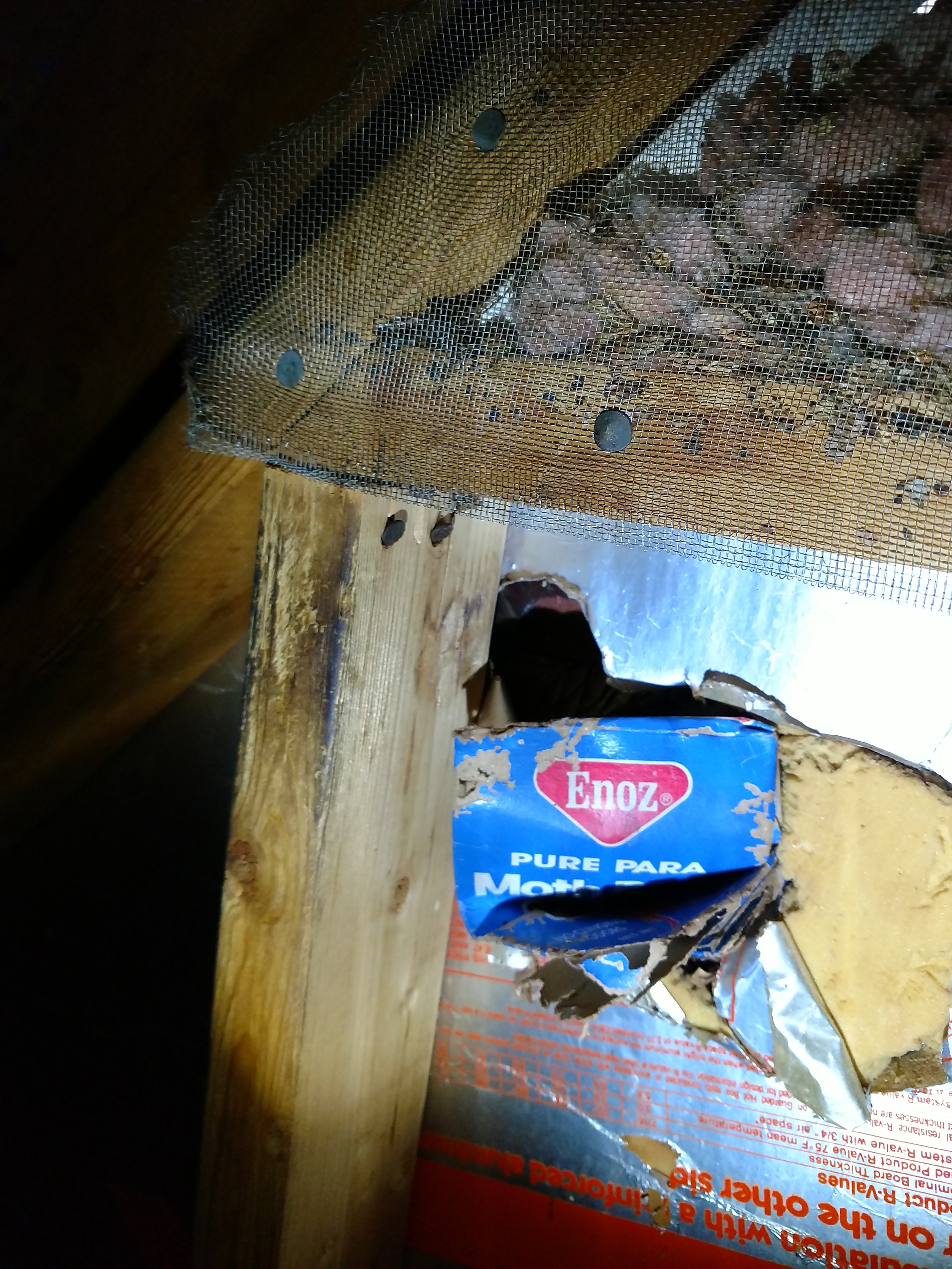USING MOTHBALLS TO EVICT WILDLIFE
The picture shown here was taken from a customer’s attic. The moth ball box was crammed into one of the identified entrance holes used by flying squirrels in their attic. Obviously, if we were called, the moth balls weren’t doing their job.
Many customers ask if it is possible to force their nuisance wildlife species out of their home with mothballs. Mothballs, otherwise known as naphthalene, evaporate to create a vapor that is toxic to moths. If a small amount of mothballs are enclosed with stored clothing in a small space (storage trunk), it prevents damage to clothing. However, naphthalene can be toxic to people at high concentrations. If enough moth balls were applied in living spaces to truly solve the problem, it would make homeowners sick as well as the wildlife. Naphthalene is also a carcinogen, linked to hemolytic anemia, kidney damage, and liver damage. If you can smell mothballs, you are inhaling a carcinogen!! Naphthalene can also be absorbed through the skin and that is more than a little scary! As a little boy I once found a “treasure” in the floor of the boy’s bathroom. I stuck it in my pocket to take home. My leg started burning a couple of hours later and I decided to discard the napthelene cake.
Mothballs may have some limited effect in discouraging wildlife from using living spaces. Though there are several products made from moth balls on the market, naphthalene does not repel snakes. If wildlife has already established a den or nest, mothballs are unlikely to be effective. Denning mothers are very dedicated to their den site. Moving young is hard or extremely risky for the mother. Also, any animal that has discovered a quality food site, raised young there previously, or otherwise satisfied its needs there will be reluctant to leave the area. The wildlife that is using your home considers it their home too. Think of it in human terms - they are about as attached to their living space as you are. If your neighbor added a stinky pig pin next to your property line, would you immediately move away? Probably not.
The effects of mothballs are temporary, at best, so leaning on mothballs to solve problems is inviting failure. Moth balls slowly evaporate away. The smell of mothballs is simply the vapor created as they vaporize. At some point the moth balls vanish and vapors diminish. Homeowners who toss a few mothballs in, walk away, and then forget about the problem are asking for a repeat of the problem later. The entrances, cozy nesting cavities, and other features that attracted the nuisance animals are still present after the moth balls vanish.
Additionally, wildlife will become habituated to the smell of the mothballs. After some time they get used to the smell as “part of the landscape” or become “nose dead” and the mothballs no longer have an effect. One customer that we worked for was a prime example of how this “nose dead” problem would affect wildlife behavior. This customer suffered a serious problem with rats in her barn and was concerned that they could wind up in her home which was close to her house. Rats could be seen openly scurrying about in the barn and five or ten rats could easily be seen in a short period in the barn while others could be seen in an adjoining dog lot. In short, this customer had a very high concentration of rats and they could be easily spotted in the open around her barn, especially during feeding time. She had to actually “shoo” rats away so that livestock could eat in peace.
This customer had applied mothballs liberally in her barn as well as in her house before I inspected her site. The mothballs seemed to have no effect on her rats. Several bags of mothballs had been placed in a storage room with little effect. The first time I opened the door to this room, a large rat was seen running for an escape hole only a couple of feet from one bag of mothballs. Generally speaking, she had applied plenty of mothballs; but still had plenty of rats. However she did note that for a short period after the mothballs were applied, activity seemed to let off in that area. This customer received no relief from the application of the moth balls. However, a comprehensive program of trapping, and management of livestock feeds did reduce the problem to an acceptable level.

